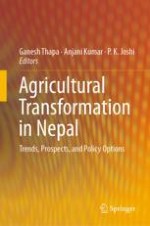2019 | OriginalPaper | Buchkapitel
15. Trends, Structure and Drivers of Nepal’s Agricultural Trade
verfasst von : Ramesh Sharma
Erschienen in: Agricultural Transformation in Nepal
Verlag: Springer Singapore
Aktivieren Sie unsere intelligente Suche, um passende Fachinhalte oder Patente zu finden.
Wählen Sie Textabschnitte aus um mit Künstlicher Intelligenz passenden Patente zu finden. powered by
Markieren Sie Textabschnitte, um KI-gestützt weitere passende Inhalte zu finden. powered by
